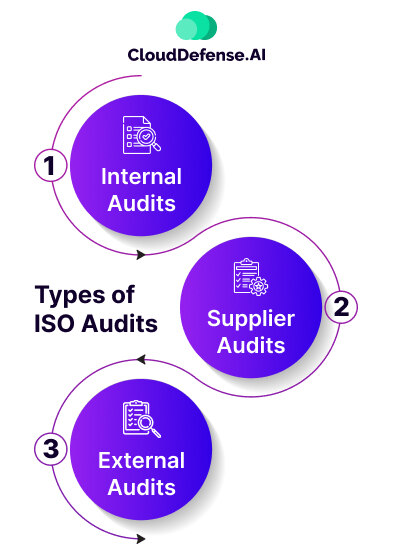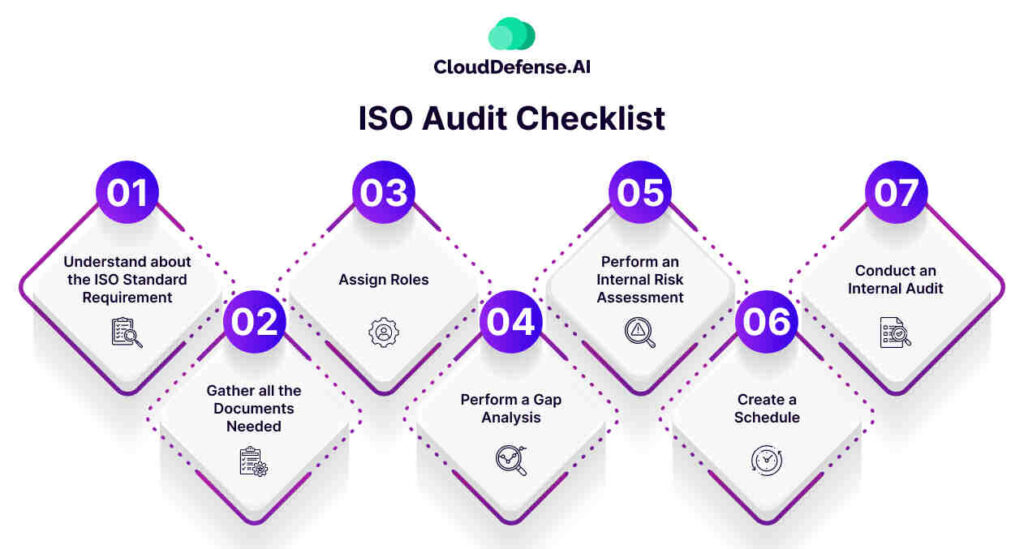The International Organization for Standardization, or ISO, is the go-to regulatory body to get preset standards for different commercial and industrial operations. ISO compliance is beneficial in ensuring your customers that the overall safety, sustainability, and effectiveness of the operations and services of your organization are up to par.
However, the compliance process can be a bit tedious for companies aiming to get this crucial certification on their portfolio. The extensive requirements of conducting yearly ISO audits can be a bit overwhelming, but a well-planned strategy can save you from that struggle.
A quick read of this article will empower you with all the intricacies of the ISO audit process and the best practices that you need to be aware of to be compliance-ready!
This comprehensive blog will contain
- What an ISO audit is and its many types.
- The importance of conducting ISO audits.
- An ISO audit checklist catered for your company.
- Tips for you to champion the ISO audit process.
Let’s dive right in!
What is an ISO Audit?
ISO audit is an audit process in which your organization evaluates and confirms that it is complying with the set standards. In other words, the audit can be defined as an onsite verification process to ensure processes and procedures in your organization comply with the ISO standard.
The audit process mainly verifies that the organization possesses the set standard of quality, safety, and security of the product or services. The audit process also demonstrates that there is consistency when the processes are implemented.
Importantly, it also helps the organization identify the areas that require improvement and critical processes for the organization. The standard followed during an ISO audit is the ISO 19011:2018 guideline, which is designed for auditing the management system. The ISO audit is only done by auditors from a reputed, notified, accredited ISO.
An organization can either go for ISO compliance or ISO certification during an audit. ISO compliance refers to enforcing various processes, policies, and procedures that align with the intended ISO standard that the organization wants to achieve.
For ISO certification, the audit is done by an internal auditor every five years. However, ISO certification involves all the processes and procedures that are done during ISO compliance, along with a formal third-party audit by a recognized auditor.
Types of ISO Audits
ISO audits are mainly of three types. They are internal audit, supplier audit, and external audit. An organization can choose any depending upon the organization’s requirement, compliance, certification goal, scope, and budget. Let’s talk about each ISO audit type.

Internal Audits
An internal ISO audit is a common audit type widely conducted by organizations by their own auditors. Internal audits are conducted by organizations to achieve ISO compliance, and they give them a competitive edge in the market.
It not only allows organizations to prepare for ISO certification or recertification audits but also helps them showcase that the organization is adopting ISO standards. In internal ISO audits, an organization looks for a management review, and depending upon the audit result, they take any necessary actions. In this first-party audit type, the result should be communicated to the top-tier management and stakeholders.
Supplier Audits
Also known as second-party audits, supplier audits are conducted by an organization over the supply chain provider or supplying organization. Supplier ISO audits are crucial for many organizations dependent on other businesses for various essential services, products, and materials.
A compromise from the supplier side will filter the purchasing company, leading to severe issues in the infrastructure. So, conducting supplier audits helps the primary organization to stay compliant with ISO standards and maintain proper security posture. It serves as one of the best security practices for most organizations that rely on suppliers for their operation, as many recent security breaches have occurred due to vulnerability from the suppliers’ end.
External Audits
External audits are widely conducted by organizations through a third-party auditor when they want to comply with ISO standards. External ISO audits can only be performed by a third-party auditor from a firm that is accredited by the ISO. There are different types of external audits when it comes to compliance with ISO standards.
Certification and Rectification Audits – When an organization wants to achieve ISO certification, it needs to perform a certification audit. This audit is done by a certification body. After an audit, they provide a certification that can be used for three years.
For example, in ISO 27001, the audit will first assess your information security management system, and then, for the next two subsequent years, a surveillance audit will be conducted.
Surveillance Audits – Surveillance audits are conducted by organizations after they have achieved ISO certification. The organization schedules one surveillance audit every year until the requirement for a recertification audit. A surveillance audit is all about reviewing your management system along with the corrective measures taken to rectify non-conformities and steps taken after recommendations from internal audits.
Why an ISO Audit is important?
An ISO audit is vital for an organization for various reasons. It is primarily for the assurance of quality and competence it showcases. Here are some prominent reason that makes ISO audits highly important.
Robust Risk Management Strategy
ISO audit helps your organization create a robust risk management strategy and enables you to identify weak spots. During the audit, it highlights the areas where there is a non-compliance issue and allows your organization to make necessary adjustments to precisely comply with the ISO standard requirement.
Better Credibility and Reputation
An ISO standard has always been a sign of quality and assurance widely recognized in different industries. When an organization achieves ISO certification, it not only helps them gain credibility among peers but also helps them provide assurance to customers, stakeholders, and partners.
Adhering to International Standards
Achieving ISO certification helps organizations adhere to many globally recognized regulations and standards. Since ISO audits evaluate many essential aspects of an organization’s products and processes, like quality, information security, and infrastructure, they help demonstrate the organization’s commitment to many regulatory frameworks.
Better Operational Efficiency
During an ISO audit, an ISO auditor thoroughly assesses all the policies, procedures, and processes that an organization has in place. This assessment helps identify the gaps, risks, and areas that require improvement. Thus, it helps the organization to take necessary steps and improve operational efficiency and effectiveness by a large margin.
Achieving a New Customer Base
ISO audit plays an instrumental role in helping organizations find a new customer base that prefers to rely on organizations adhering to international standards.
Most specifically, it allows them to garner attention from government bodies and international brands that prefer to work with ISO-certified organizations. An ISO compliance or certification helps the organization showcase its commitment to delivering quality services or products.
Competitive Advantage
When your organization receives certification after an ISO audit, it gives your organization a competitive edge in the market. It opens up a new door in the market and broadens your customer base. Not every organization can easily achieve ISO certification, so the audit helps your organization stay ahead of the curve and gain more attraction.
ISO Audit Checklist
When it comes to ISO audits, you have to be careful with your approach, as it will help you to achieve compliance with an ISO standard. Here are some general checkpoints you should maintain for an ISO audit.

Understand about the ISO Standard Requirement
Your first step is to familiarize yourself with the ISO standard requirement your organization wants to pursue. You need to review every document for the ISO audit and understand each part before you schedule the audit. You can consult with an expert while going through the document to gain an accurate understanding.
Gathering All the Documents Needed
Documentation is an essential aspect of an ISO audit, and you need to gather all the required documents to streamline the audit process. All the documents supporting your implemented policies, procedures, and tools should be collected before you start the audit process.
Assign Roles
The next step for your ISO audit checklist is to gather your team and assign roles based on their expertise. You will have to understand their expertise and designate specific roles so that they can perform lengthy and in-depth tasks.
Perform a Gap Analysis
You should perform a gap analysis on your ISMS and document and assess how it complies with the intended ISO standard. The analysis will highlight all the compliance gaps and how much time will be needed to prepare for the ISO audit. It is also highly useful for creating a roadmap for the compliance journey.
Perform an Internal Risk Assessment
Your next task is to perform an internal risk assessment that will help you discover the known risks to the data and infrastructure. The risk assessment will not only help you identify the risks but also document them. You can utilize a risk matrix to prioritize risks that are likely to make the most impact.
Create a Schedule
Now, you must create a schedule and complete all the tasks according to the schedule. The scheduling is beneficial during the implementation of controls and ensures you have implemented all the correct controls in the ISMS. While scheduling, you should include some buffer time for any unforeseen situation.
Conduct an Internal Audit
Once you have discovered all the risks, documented everything, and implemented all the controls, it is time to conduct an internal audit. This audit will prepare you for the official audit and test your implemented controls. Notably, the internal audit will also give the chance to make final adjustments before the official audit.
How to Conduct an ISO Audit Process
Conducting an ISO audit requires careful planning and execution to comply with the intended ISO standard easily. Most of the time, for ISO compliance, the ISO audits are done either onsite or remotely.
First, an internal audit is conducted, and an auditor conducts them according to the audit checklist. Before the audit, the auditor should explain all the details, like the purpose, scope, and other aspects of your organization. Then, during the internal audit, the auditor will assess all the gathered documents and process performance to compare them with ISO standard requirements.
During the audit, you should also check whether the specific audited process is still relevant to the ISO standard. All the risks, gaps, and issues identified during the internal audit should be discussed with the auditee organization.
After proper discussion, the auditor will be able to define the mitigation procedures so that the team can prevent such occurrences in the future. In the final stage, the auditor will have to present the final audit result for the management review.
The evidence collection is a requirement for the management system, so it should be followed. In the management review, all the necessary evidence will be gathered, which will then be reviewed by a team of experts from your organization. After the analysis, all the findings and non-conformances should be documented.
5 Tips for Preparing ISO Audit to Expedite the Process
Preparing for an ISO audit to ultimately expedite the process requires proper planning and approach. Moreover, while accelerating the process, you must maintain thoroughness and balance. Here are five tips to prepare for the ISO audit to expedite it.
Determine the Objective
To expedite the ISO audit process, the primary step thing you need to take is to determine the objective behind the ISO audit. Understanding your objective will give you a clear roadmap that will help you streamline the audit process.
If you want to get ISO certification, you should create your audit schedule accordingly. The whole process can be time-consuming, but when you understand your objective, it helps you streamline the process. Understanding your organization’s audit objective will help you save time and accelerate the whole ISO audit process.
Prepare the Audit Checklist
Another helpful way to expedite the ISO audit is by creating an audit checklist that will act as a guidebook and adhere to the ISO audit guidelines. The audit checks help you understand how the ISO audit fits with your business objective and what things you need to do to achieve ISO compliance.
The checklist covers each component of the ISO standards and checks whether you are meeting all the requirements. The checklist also helps you assess the areas of the system or process where you need to modify or rectify.
Keep All the Documents Ready
If your main objective is accelerating the ISO audit process, you must keep all the documents ready. Having all the necessary documents ready when a third-party auditor conducts an ISO audit will shorten the audit time and help the auditor streamline the process. If an audit doesn’t find all the evidence they need, it can delay the whole process and cost a lot of resources and time.
Initiate the ISO Audit Schedule
Initiating a particular schedule for the ISO audit will be highly helpful in expediting the ISO audit process. When you create an audit schedule, it helps your organization to achieve goals smoothly.
Creating a schedule allows you to delegate different tasks and assign them to the right team members. The scheduling should start with your internal audits, and you should also schedule all the projects that will ultimately aid the quick completion of the ISO audit.
Perform Internal Audits at the Beginning
It is best to perform an ISO internal audit before performing an ISO certification or external audit. Conducting an internal audit will help you find the areas that require modification, know about the progress, and improve the overall process and procedure to align with ISO audit requirements.
Importantly, this kind of audit will prepare you for the documents and questions that may arise during an actual ISO audit.
FAQ
How long does it take to complete an ISO audit?
How many stages of ISO audit are there?
How often are ISO audits required?
After the first year of ISO certification, an ISO surveillance audit will be conducted in each of the next two years, and after the audit, the organization will be recertified.
What happens during an ISO audit?
The documents carry all the procedures, processes, products, records, policies, and work instructions implemented by your organization. If all the documents cater to the ISO standard requirement you are pursuing, then the certification body will present you with ISO certification.
Conclusion
ISO audit is a lengthy and tricky process, and expediting it is not a straightforward task. However, with our 5 tips to expedite the ISO audit, you can accelerate the process and achieve ISO compliance or certification without wasting unnecessary time. All the tips will prepare you for the final ISO audit by the auditor, which will ultimately streamline the whole audit process.







